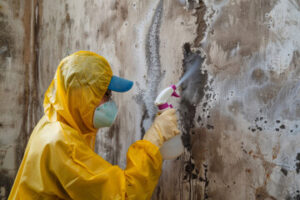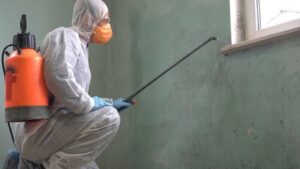A trained Mold Removal In Brooklyn specialist will come to your home and determine what steps are needed to remove the mold. Before they arrive make sure to document the contamination as best you can.

Standard household bleach is able to kill mold on non-porous surfaces, but it cannot penetrate into materials like wood or drywall. Vinegar, on the other hand, can.
Some homeowners and contractors believe that mold removal must involve killing the mold first, as if it were some sort of germ or bacteria that needed to be “snuffed out” before it got out of hand. The truth is that successful mold remediation does not involve fogging or spraying any EPA-registered biocide to kill the mold; it involves finding the source of the mold and eliminating it by fixing the moisture problem that caused it to appear in the first place.
The mold remediation process typically starts with a thorough inspection of the area to determine the extent of the contamination. Then the workers suit up in head-to-toe white suits, boots and respirators (except in crawl spaces where a double tent may be set up). They then enter the contaminated area and apply a thick liquid called a biocide that is approved by the EPA to kill mold spores. This usually takes several hours to set and must be allowed to dry completely before the space can be used again.
While the biocide is working, the mold remediation crew focuses on cleaning and wiping surfaces. They also use HEPA vacuums to remove any lingering mold debris and spores. They may also clean and disinfect personal items such as carpet and clothing that have been contaminated.
After the mold is killed the team moves on to the cleanup phase which includes removing and disposing of all contaminated materials, including porous building materials such as drywall. They may also need to replace items such as carpeting and insulation if they have been severely damaged by the infestation. Then they must clean and dry the affected areas thoroughly using fans or dehumidifiers.
Mold can produce mycotoxins that are harmful to humans. These mycotoxins can be especially toxic for children, seniors and people with weakened immune systems. While there is no evidence that the mycotoxins in most molds are dangerous to healthy adults, it is always best to be safe than sorry.
Many mold remediation companies now offer a less-toxic alternative to biocides that still kills the mold but does not contain chlorine bleach. There are also a number of natural cleaning products on the market that are designed specifically to remove mold. These products are usually based on thyme oil and should be used according to the instructions on the label.
Removal
Mold is a type of fungus that thrives in humid environments. It grows from tiny spores that float in the air and land on moist surfaces, where they grow into colonies. Some types of mold are harmless, while others can trigger health problems and damage property. Mold growth can be difficult to notice, especially if it is hidden in crawl spaces or behind walls.
Mold removal involves the physical removal of mold spores from a surface. It is a common method used for small areas of visible mold, and it can be effective in reducing the symptoms of mold exposure. It does not address the underlying cause of the mold growth, however, so it is often combined with remediation to prevent future infestations.
Remediation is a more comprehensive process that includes containment, cleaning, and prevention. It is typically recommended when a homeowner has serious or extensive mold contamination, and it can be used in conjunction with other methods of mold removal to reduce the risk of further mold outbreaks.
Before beginning any work, a mold remediation professional will isolate the area to keep the spread of mold spores from contaminating other parts of the home. They will use plastic sheeting and other materials to seal off the affected space, and they may also use negative air ventilation systems to remove dirty indoor air and replace it with fresh outdoor air.
Once the area has been isolated, professionals will begin removing any damaged building materials. This could include drywall, carpeting, and insulation. They will carefully bag the materials and dispose of them according to EPA standards. The team will then clean and disinfect the remaining surfaces of the home to remove any lingering mold spores. They will spray a special biocide that is approved by the EPA to kill any remaining spores.
Finally, they will apply a mold resistant coating encapsulating product to the entire home to stop new mold growth and prevent future infestations. After completing the remediation, they will test the air quality of the home to make sure it is safe for homeowners to return.
Disposal
Mold spores can be dangerous when inhaled or ingested, so if you suspect that your home is affected by a mold problem, it’s best to leave the removal and disposal of the material to professionals. This process will ensure that the mold spores don’t spread to other parts of the house and prevent further infestation. It’s also essential to take steps to ensure that the mold doesn’t return once it has been removed, which is why a comprehensive mold remediation strategy should be implemented, including containment, cleaning, and prevention.
The first step in the remediation process is to spray an EPA-approved biocide on the affected area, which will make the mold spores sterile and stop them from spreading. Non-porous items like bathtubs, countertops, and metals can usually be cleaned and sanitized without further issue, but porous materials such as carpeting and fabric-covered furniture must be discarded. These materials should be placed in thick plastic bags and double-bagged before being disposed of, with the outsides of the bag being wiped down to remove any hidden spores that may still be present.
During this phase, the professionals will also inspect the area for signs of moisture damage or leaks that could be contributing to the mold growth. This is because mold spores are spread by water and can attach to surfaces and sprout new growth, so it’s important to find out what’s behind the contamination before you attempt to remove it.
This is why it’s essential to use a professional service that understands and follows the relevant laws regarding contaminated waste. This will ensure that the disposal process is safe and that any hazardous chemicals don’t leach into the surrounding environment and cause additional problems.
Once the biocide has been sprayed, the professionals will begin the removal process by carefully disposing of any affected building materials. This includes drywall, insulation, and carpeting. This can be an expensive and time-consuming process, but it’s vital to protect your health and the integrity of your home. After removing the contaminated material, the professionals will disinfect and wipe down any remaining surfaces with disposable materials to make sure that the spores are completely eliminated.
Cleaning
Mold is a type of fungus that thrives in areas with high moisture. It can grow in bathrooms, kitchens, basements and sink cabinets where condensation is common. It can be black, white, green, purple or orange and range from small, penny-sized spots to taking up entire walls. Whether it’s a minor outbreak or a major contamination, there are multiple ways to clean up the mess.
Mold needs to be scrubbed, sanitized and deodorized to kill it. A common technique is to mix a teaspoon of soap and two cups of water in a spray bottle. Apply this mixture to the affected area and scrub it with a stiff brush. Then, rinse the surface and wipe it down with a paper towel, making sure to soak up the excess water. You can also use borax to kill the mold roots. It works by soaking into the wood and killing it.
Another way to clean is by sanding the mold off of the wall or surface. This can be very effective, but it’s best done with a respirator and gloves to protect against the dust particles that will be stirred up. It’s also important to keep the work area as dry as possible during this process. This can be difficult in an area that has been extensively contaminated by a large amount of mold.
A professional restoration company can use a variety of methods to clean up the mold and sanitize the work area. Some of these include:
Typically, near the beginning of a remediation project, a contents pack out will occur. This is when a restoration company removes any saveable contents such as textiles, clothes, hard goods, photos and electronics that are affected by mold. These items are taken off site to be cleaned and restored. This can help to reduce the amount of spores that are spread throughout the property and can prevent further contamination in areas where the contaminant has not yet reached. If the contents cannot be saved, they are disposed of in 6 mil plastic bags, double-bagged and tied shut to avoid releasing spores into the air.
